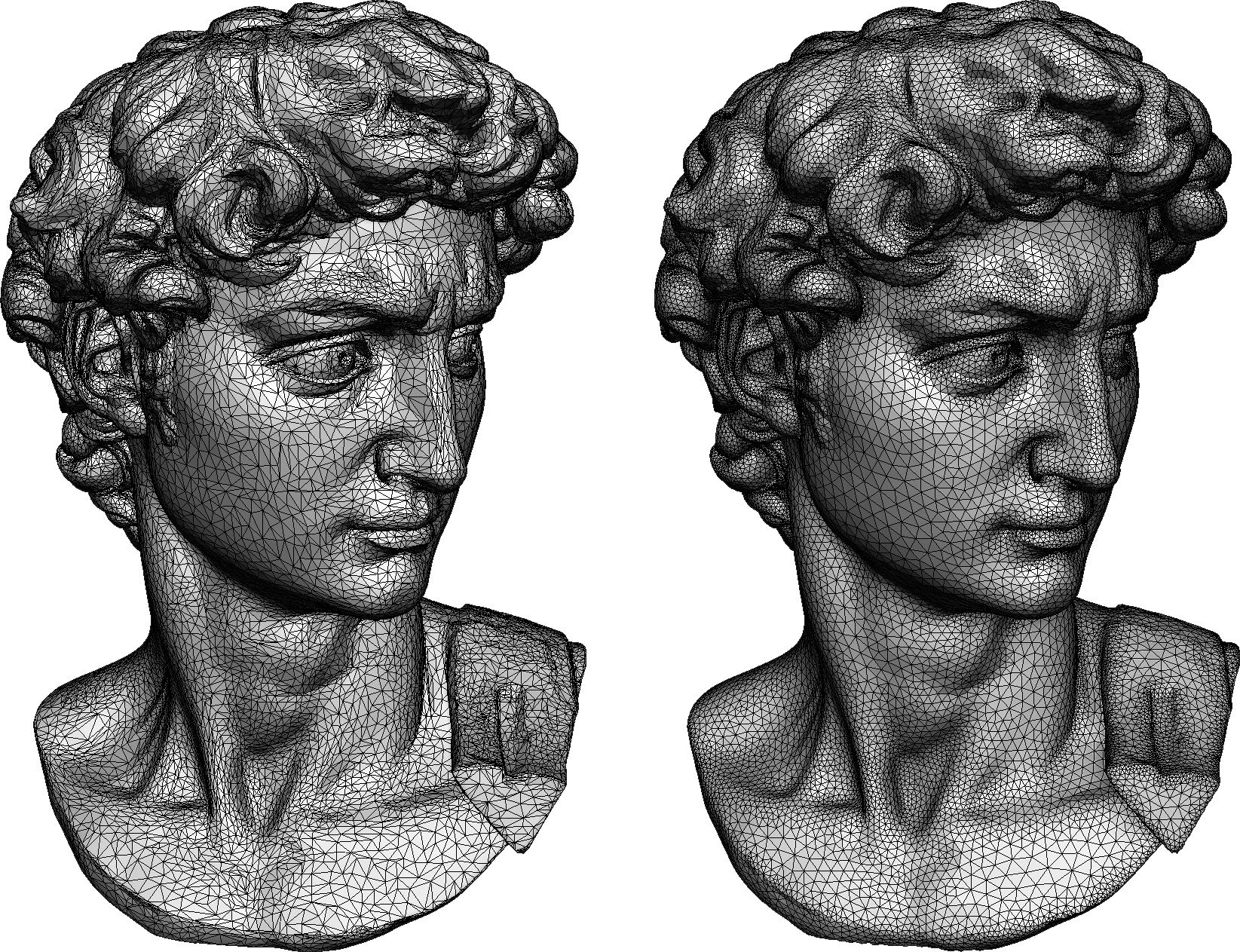Surface remeshing improves mesh quality, optimizes data storage, and enhances visualization. This is beneficial for applications such as numerical simulations and animation. The goal of this project was to implement the curvature-adaptive surface remeshing by Dunyach et al. (2013) into the CGAL's isotropic remeshing framework. The method operates iteratively, performing the following steps:
- Edge collapsing and splitting based on targeted resolution,
- Edge flipping to improve valence (target is 6 in the interior and 4 on boundary),
- Tangential smoothing to optimize vertex distribution, and
- Vertex reprojection onto the original surface to preserve exactness.
The main contributions of this project were made in edge collapsing and splitting, and the tangential smoothing. The new edge splitting and collapsing rules depend on the local target edge length which is calculated from the vertex sizing field. The sizing field is derived from the discrete curvature implemented in a previous GSoC's contribution. This means that regions with a larger absolute curvature will result in smaller triangles and vice-versa.
The new tangential smoothing was implemented to account for varying edge lengths. Weights of the tangential smoothing are proportional to the triangle area divided by the sizing field at triangle's barycenter.
The implementation is independent of a data structure and it works on whole meshes, as well as selected surfaces. It also works with feature preservation and constraints. Finally, the functionality was incorporated in GUI through the polygon mesh processing plugin of the CGAL's Polyhedron demo.
In summary, my contributions to the project include the following:
- Introduction of the
PMPSizingFieldconcept, - Implementation of the
Adaptive_sizing_fieldclass, - Introduction of the
tangential_relaxation_with_sizing()function that takes sizing field values as weights in tangential relaxation, - Changes to
split_long_edges()andconstraints_are_short_enough()functions to work with the sizing field, - Implementation of changes to Polyhedron demo (
Isotropic_remeshing_plugin.cppand the GUI), - Documentation, example
isotropic_remeshing_with_sizing.cpp, and a testremeshing_quality_test.cpp.
The starting point for the project was the initial work done in the original pull request, where the target_edge_length argument was replaced by a Uniform_sizing_field class derived from a Sizing_field_base virtual class. I generalized the Sizing_field_base and Uniform_sizing_field classes with a vertex point map template argument. Originally, the functions used the default vertex point map of a polygon mesh; this is now a default template argument.
From the Sizing_field_base, I created the new PMPSizingField concept that can be used to create new sizing fields. The classes created from the PMPSizingField concept should contain mesh edge splitting and collapsing rules through is_too_long() and is_too_short() functions, as well as a function to define a new point for edge splitting split_placement().
Other functions that initially used prescribed target edge lengths were modified to accomodate the concept. This includes split_long_edges() and constraints_are_short_enough() functions.
I impemented a new adaptive sizing field class in Adaptive_sizing_field.h. It uses the approach proposed by Dunyach et al (2013). Similar to the Uniform_sizing_field, edges are split if they are longer than the 4/3 of the target edge length and collapsed if they are shorter than the 4/5 of the target edge length. The target edge length is local and calculated from a discrete curvature.
We start by calculating a discrete curvature using the interpolated_corrected_principal_curvatures() implemented in a GSoC 2022 project. The sizing for individual vertices is calculated as
where the curvature
Sizing values for vertices is_too_long() and is_too_short() functions, respectively. Furthermore, to prevent extreme values, the edge sizing is constrained between user-defined minimum and maximum limits.
The sizing field can be calculated for the whole mesh or a selection. In case of a selection, the curvature is calculated from the selection expanded with one layer of neighbouring faces (expand_face_selection() function). Additionally, as derived from the Sizing_field_base, the input can be a user-defined vertex point map.
The curvature calculation also incorporates the ball_radius named parameter, which can smooth a noisy curvature field
The sizing field is updated when the edge is split. Since the edge is split at the midpoint, the new vertex sizing is calculated as an average of the two initial sizing values.
I implemented a new tangential relaxation function tangential_relaxation_with_sizing() which moves points using the expression
where
I updated the Isotropic_remeshing_plugin.cpp of the Polyhedron demo with the adaptive sizing field, as well as added the adaptive sizing field functionalities to the GUI with the Qt Designer.
I updated the isotropic_remeshing_with_example.cpp test to showcase the new functionalities.
I added the remeshing_quality_test.cpp that calculates the triangle quality value as
Lastly, I updated the reference and user manual to reflect on all of my developments.
Khan et al. (2020) made a comprehensive literature review on surface remeshing algorithms. Future work could explore other remeshing options and enhancements highlighted in the literature, especially those promising improvements in robustness and resulting mesh quality.
It was a fun and useful project that combined different skills such as computational geometry, C++ template metaprogramming, and Qt. I would like to thank my mentors Jane Tournois and Sebastien Loriot for insightful discussions and consistent support.
